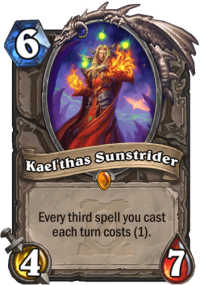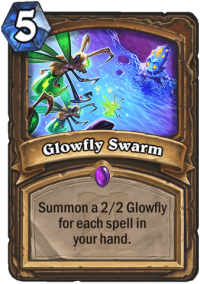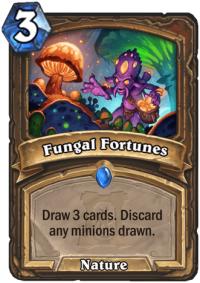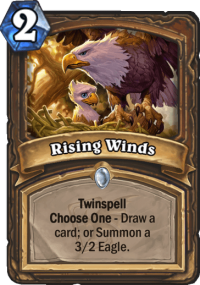Our Spell Druid deck list guide for the Ashes of Outland expansion will teach you how to play this budget list. This guide includes Mulligans, Gameplay Strategy, Card Substitutions, and Combos/Synergies!
Introduction to Budget Spell Druid

Spell Druid is a new archetype introduced in Ashes of Outland, but the general idea behind it isn’t exactly new. It’s kind of a spiritual successor to Token Druid decks. Your main game plan is to flood the board with minions, make them stick and then kill your opponent with attack buffs. However, the way you do it is very unique. Instead of trying to establish board control from the first turns, you usually skip them or draw more cards / ramp and only really start playing in the mid game.
Thanks to the mana cheating of Kael'thas Sunstrider, the deck has some really explosive mid game turns. In some cases, you can have a 30+ mana turn starting with a mere 7 mana crystals. Of course, things don’t always work that way, but if you pull it off, it’s just an instant win.
This build is basically a meta version – and given that it’s pretty strong if you learn how to play it correctly, you should easily be able to climb ladder with it. In fact, I’m pretty sure that this build is even Legend-capable.
Check out Hearthstone Budget Decks & Guides for All 10 Classes!
Budget Spell Druid Deck List
Budget Spell Druid Mulligan Guide
Higher Priority (Keep every time)
- Fungal Fortunes – Possibly the best card to have in your opening hand – drawing 3 cards for 2 mana is amazing. While you can miss sometimes and draw a minion, with only 2 of them in your deck, it’s pretty unlikely. It gives you more options, possibly draws you ramp and adds more spells to your hand.
- Overgrowth – Your ramp card – the thing about this deck is that you really want to get to 7 mana as soon as possible for a few reasons, and if you play Overgrowth on curve you land at exactly 7.
- Glowfly Swarm – Most of the time, it will summon 5-7 2/2’s for just 5 mana. While you ideally prefer to combo it with something, just playing it on curve is great in most of matchups. Against faster decks, it will give you bodies to deal with their minions, and against slower decks you can even threaten an early lethal sometimes.
- Kael'thas Sunstrider – Kael’thas is a core card in your deck and a reason why you can pull off those crazy combos. Having him in opening hand not only means that you will be able to start comboing on Turn 7, but you also won’t hit him with Fungal Fortunes and discard it.
Lower Priority (Keep only if certain conditions are met)
- Crystal Power / Wrath – Your early game removal cards, keep them against Aggro if you know that you will need to answer some early game threats. For example, you can’t afford to leave that Battlefiend – you will just die (and punching it two times with Hero Power is also not a great idea).
- Exotic Mountseller – You can keep it in slower matchups you already have Overgrowth in your hand. The card is great, but it’s too slow to keep without Ramp or against Aggro.
Budget Spell Druid Play Strategy
Let’s start by outlining your basic game plan. Your goal is to flood the board with minions and finish the game with buffs / Savage Roar. Sounds very simple, right? And sometimes it is, but you will often have to work hard for it.

You have three ways to summon minions on the board. The first and arguably strongest one is Glowfly Swarm. Most of the time, it will be 5+ 2/2’s on the board for just 5 mana – later in the game when you’re doing your combos it will nearly always be 7x 2/2. The card is just insane in this build. The second way is The Forest's Aid, a card well known to Token Druid players. This time you need to pay 8 mana for 5x 2/2, but the main upside is that it’s Twinspell, so it has two uses. And last, but not least – Exotic Mountseller. You need to follow it with a bunch of cheap spells (which is not hard), and sadly the outcome is pretty RNG… You can summon 1/1 (Desert Hare), 2/1 (Ironbeak Owl), but also Bad Luck Albatross or King Mukla… On average, however, it’s going to be a solid board. None of those boards is AoE-resistant, though, that’s why you also need Soul of the Forest. Another classic Token Druid card, if you flood the board first and THEN play Soul of the Forest, even if your opponent drops an AoE, you still have a bunch of 2/2’s. There are still ways to answer that – two AoEs, board clears that negate Deathrattles (Plague of Death, The Amazing Reno) etc. But many decks won’t have a way to clear it, and that’s where you strike.
After you build a solid board and stick it, next turn is key. Once you can attack with your minions, your buffs come into action. You can both make your board more defensive/offensive with Power of the Wild / Gift of the Wild, or just try to straight up kill your opponent with Savage Roar. Let’s say that you ended up with 5x 2/2 on the board going into your turn. That’s 10 damage, which is not bad. But then if you add Power of the Wild and Savage Roar, suddenly it’s 27 damage. Slam Hero Power, maybe a Moonfire or two and you can kill your opponent from full health.

But first, you need to get through your very weak early game. The best cards to have are obviously Fungal Fortunes and Overgrowth. Former lets you draw more cards, have more options, possibly make your Glowfly Swarm stronger. Latter lets you get to Turn 7 quicker. But why Turn 7 in particular? Because that’s when Ironbark and Bogbeam become free, which means that it’s way easier to do your Kael’thas and Exotic Mountseller combos. It’s also the turn you can play Overflow to heal yourself up a bit and draw a lot of cards if you don’t have Kael/Mountseller yet. Notably, 0 mana Bogbeam will also be very handy to not lose too much tempo while drawing your deck. After you get to mid/late game, balance between clearing your opponent’s stuff and building a board. You can often do both of those at once. If necessary, heal yourself up with Overflow or Crystal Power.
One interesting thing and a piece of advice is that Kael looks for a third spell you cast on a given turn, no matter if he was on the board before or not. For example, you COULD Coin + Innervate him out on Turn 4 and then follow up with a big Overflow or Forest’s Aid. And very often that’s the way to go. That’s easily enough value to get from him. And one more thing, because I’ve actually seen players conceding after discarding Kael with Fungal Fortunes… Don’t. It’s not the end of world. Kael is useful and he lets you do those crazy turns, but you don’t need him to win. For the same reason, don’t be afraid to play Fungal Fortunes – if you end up discarding one (or even both) of your minions, too bad, but it’s NOT worth to wait until you draw them before playing Fortunes. Holding it will end up with many more games lost than playing it and discarding Kael.
Future Card Replacements for Spell Druid

The best thing about Spell Druid is that the deck is very, very cheap. Since Kael'thas Sunstrider is free and Glowfly Swarm is the only necessary Epic, the deck can easily be built on the budget, without spending almost any Arcane Dust.
The only card that is missing from the meta list is Rising Winds. We’ve excluded it since it’s an Adventure card. If you own it, however, remove 1x Treenforcements and 1x Moonfire and add 2x Rising Winds instead. The card is better mostly because of its flexibility – it can be used to create some board presence or cycle through the deck, whichever is necessary at the time.
That said, even without Rising Winds, the deck is still fully capable of climbing on the ladder. Adding those is only going to be a minor improvement.


















